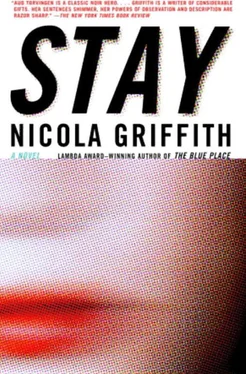The drip and runnel of rain ran counterpoint all day to the rasp of steel on wood. I worked steadily, but she kept stopping and staring off into the distance, then looking at her saw as though it had appeared in her hand as unexpectedly as a dinosaur bone.
The next day was beautiful, hotter than it had been for a while, and Tammy, whose sawhorse stood in the sunlight streaming through the door, sweated while she worked. Her scent—earthy and light, like the smell of crisp baby carrots when you first pull them from the ground—mixed with that of sawdust and leaf mold. She pulled a handkerchief from her pocket, wiped her face, and bent once again to the board she was recutting. Muscle flexed in her thigh as she steadied the wood against the sharp rip of the saw. The shorts were mine and fit snugly. I turned away and drank some water, then contemplated the walnut I’d been working.
Walnut is a hardwood that cuts and splits almost as easily as pine, but its real value is its beauty. The grain of the three pieces I had cut and polished for the handrail up to the loft could have been painted by a long-ago Chinese artist. Imagine porous paper stretched tight under a silkscreen, healthy dollops of gold and saffron ink, smaller ones of chestnut, tiny, tiny pinpricks of some color paler than the winter sun, the sudden back-and-forth of the wedge, and while the wavy lines bleed into each other, the artist dips his fine brush in umber ink and paints on careful rosettes which spread like the ripples in a pond. Then, while the ink still glistens, he sprays everything with lacquer and the surface is liquid-looking but hard, and complex as a natural fractal.
“You look like you’ve seen god,” Tammy said from right beside me.
I smoothed the wood with my palm, then looked at her. She was grinning.
“I’m done,” she said, and stepped aside so I could see the interior wall. It was finished, or one side of it was, at least. I stepped up to take a look, trying not to think about the hammer handle shoved down the front of her shorts. It was suddenly obvious that she wasn’t wearing underwear.
“Looks good,” I said. “Now help me with this stair rail.”
Two hours later, still sweating, muscles aching pleasantly, we stood admiring the finished railing and one-sided wall.
“It’s starting to look like a house,” Tammy said.
“Long way to go.”
“Jesus. Would it do any harm to pat yourself on the back, just kick back and drink a few beers?”
Julia had said the same sort of thing, more than once. “A few beers it is, then.”
We built a fire in the pit while we drank our first, and opened a second while we waited for the coals to get hot. It was about six o’clock, and the sky glowed like stained glass.
“It’ll cool fast tonight,” I said. “I’m going to put on some warmer clothes.”
In the trailer I changed into old corduroys and sweater, and tried to remember what clothes she had bought in Asheville. I took fresh beers outside.
“I laid some spare sweats on the bed, in case you needed them.” She took the empties back in with her.
Icy beer, hot fire, fading sun and total quiet. Lovely. I lay on the turf and stretched. When Tammy reemerged I propped myself on one elbow and pointed to where I’d put her beer on the log, away from the heat. She took a swallow, then squatted down opposite me to examine the fire.
I shouldn’t have lent her the sweats. She still wasn’t wearing any underwear, and the cloth was old and thin and contour-hugging. I could see, clearly, the swell of her vulva, the bone of her hip, the curve where inner thigh becomes groin. When I looked up at her face, she was watching me watch her. She bent to poke the logs, then sat, and the moment passed.
“You did a good job today. You learn fast.”
“Oh, I learn fast all right.” It sounded bitter.
I didn’t understand that. “Dornan helped me, too, when he was here. Though I think he hit more fingers than nails.” She didn’t smile. “You should call him.”
She shook her head. “I can’t. I just can’t.” Without looking at me she said, “Anyhow, I’d have thought you’d be happy to keep me away from him. You never liked me when we were together.”
There was no point denying it.
“So why’d you come find me? How’d he get you to do that?”
Because we’re friends. That’s how it works. “He knew you were in trouble—he just didn’t know what kind.”
“Neither did I,” she said. “Not at first.” Now she looked at me. “You know what my job is, right?”
“Business development.”
“And you probably think it’s a nothing job that any zero brain can do as long as she’s pretty and smiles and flirts.” I don’t like being told what I think, but this was her therapy session, not mine. “It was kind of true, at least it used to be. But then I went down to Florida, to that mall development in Naples, and met Geordie Karp.
“Geordie was… he was like a dream, you know? Famous, kind of, and good-looking and rich and great at his job. He’s probably, I don’t know, in his late forties, but he looked a lot younger. And he singled me out, and told me I had lots of talent, people talent. Then he offered to mentor me.”
I nodded.
“It was like he’d looked inside me and seen exactly what I wanted; he understood. He saw me, the real me, not the southern party girl who was fun to have around at the business meetings so you sometimes threw her a bone.”
A time-honored southern strategy.
“He was going to help me, give me the tools to be professional, he said. Then I could get what I wanted without having to flirt and smile. He’d been looking for someone like me, he said, someone worth his time. And I believed him. But it was more than that. Geordie was… Look, just don’t judge me, okay? Geordie was gorgeous. Tall, maybe two inches taller than you, and fit, sort of whippy, with curly golden hair and a red-brown beard. Soft, not like most men’s facial hair. And he knew all the best restaurants, and the people there always knew him, and he was generous, and funny, and well dressed.”
“He dazzled you.”
“Yes. And I thought I dazzled him, too, especially when the Naples project was done and he said did I want to go back to New York with him and help him in his new project. Did I tell you he’s a psychologist?”
“No.” Present tense at last. I was beginning to think she’d killed him.
“He’s a clever son of a bitch. He knows how people work inside, really knows. That’s how he got me.” That bitterness again. “Geordie earns seven figures a year telling Nordstrom and Tiffany’s and the Gap how wide to make the aisles, where to site their stores, what product should be where in relation to the door, so that consumers spend more. It’s a science. He’s got all these charts and graphs and programs—can quote numbers like a TV guy doing sports stats. The time per visit that the average American spends in a shopping mall is fifty-nine minutes, he says to his customers, down from sixty-six in 1996 and seventy-two in 1992. Then he tells them how he can make each minute worth more to them, how to maximize each square foot of retail space.”
“And can he?”
“Oh yeah. Like I said, he’s good. The best. I learned a lot from him: the downshift period, the decompression zone, the invariant right. Think about a street in New York, people walking fast to get someplace. When you walk fast, your peripheral vision narrows, so you don’t pick up visual cues well, and it takes you a while to slow down if something catches your interest—depending on how fast you’re going, you need up to twenty-five feet. So the best place to be is next to a store with a cool window display, because by the time the shopper begins to slow to shopping speed, he’s outside your place, and the things in your window will really catch his eye, and he’s more likely to come inside. So then he goes inside, but he’s still in street mode for the first ten or fifteen steps, so it’s useless putting anything near the door because he just won’t see it. That space is where the potential shopper decompresses. Once he’s begun to do that, he always—invariably, Geordie says—turns to the right. Why? Who cares, he just does. So that’s where you put the stuff you want him to notice: twelve paces in and to the right. You do that and sales go up more than thirty percent. It’s like a guarantee. And that’s just getting them inside. Geordie told me that after one retailer talked to him and redesigned their stores, gross sales climbed sixty-one percent. Since then, his contracts always include a bonus clause.”
Читать дальше












